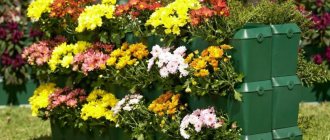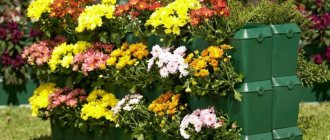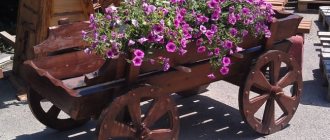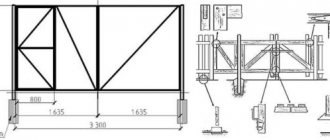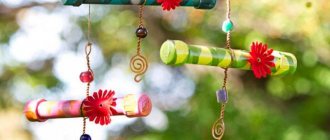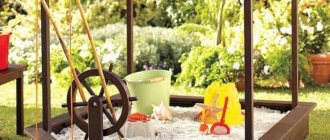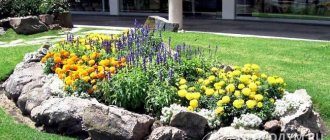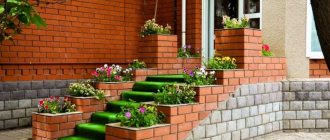Review author: Terrari School of Design
Amateur summer residents often do not know how to beautifully decorate their garden plot.
There are a wide variety of options for decorating a site. One of these is the popular type of landscape design - flower bed.
Decorative flower beds (photo) look organic and very beautiful in personal plots; they also help to disguise unsightly areas on the territory. Almost everyone without exception likes delicate floral scents; they lift the mood and pleasantly please the eye.
Flowerbeds are given an original shape mainly so that they attract attention, being the visual center of the flower arrangement.
With the help of a flower bed, you can easily and simply eliminate all the protruding unevenness in the landscape with your own hands. The right design technique will allow you to design the territory in both horizontal and vertical formats. If the land for planting is not very good, unpretentious plants can be planted in flower beds.
Creating a flowerbed with your own hands will help to beautifully decorate the area around the country house, but only if the designers and the owners themselves have a clear idea of what they will do and how correctly everything can be decorated.
Material for flowerbed design
Before creating a flower bed, it is important to select the material to create its border. Properly selected decorative fences will make the garden more interesting and easier to care for. Due to the fencing, grass does not grow into flower beds, and soil does not fall onto lawns and paths.
Decorative fences can protect flowers from trampling and visually separate them from paths and lawns. In order for a decorative fence to become a good protection against unnecessary grass, it must be made in the ground at a depth of about 25 cm.
There are a lot of different materials for decorating fencing. In specialized stores you can purchase ready-made finishing options, such as:
- plastic strips, strips, and barriers
- concrete palisades
- wooden pegs
You can also adapt natural materials (stones, tree debris, branches) or give a second life to things that have gone out of use (pallets, old bricks).
Flower beds with wide edges look very impressive. They can be made using large stones, bricks, sleepers, and concrete slabs. You can create a fence from crushed stone or gravel.
To ensure that the edge remains invisible, thin strips of plastic or metal are made; they are simply hidden under a layer of garden bark and litter. The edges of the flower garden are decorated with flowers of low-growing varieties.
By separating the flowerbed, you can make fences from unnecessary used things:
- glass bottles
- cans
- bricks
- roof tiles
- car tires
Hedge
It is not necessary to build a fence; it can be easily grown from special plants. The simplest option is a low hedge, trimmed into neat blocks or a rounded line. You can put a colorful ribbon of flowers under the hedge.
The strict geometry of such a border harmonizes perfectly with monoflower beds and garden paths made of pebbles. Artistic disorder and naturalness are also a good idea; fences made of lush, bright thickets look great.
Fencing made of large stones, boulders, concrete
Large natural stones are often used to decorate rocky gardens and flower beds. Large boulders look incredibly beautiful when enclosing a flower bed with tall flowers. Flowerbeds made of stones are easy to make yourself; they look very colorful.
The strongest and most resistant stone and concrete fences, they will last much longer than wood or plastic. They have excellent wear resistance and do not require constant maintenance. Concrete is a fairly durable material, excellent for creating edging in the form of low walls, strips that are flush with the ground.
Concrete blocks
It is not easy to get a sufficient amount of natural stone; it is much easier to build a border for a flower bed from leftover building materials. It’s a great idea to use concrete blocks; colored and shaped ones look especially good.
But even from ordinary rectangular blocks you can build an original fence, making it multi-tiered, chaotic, or painted in different colors. The main advantage of block borders is the ability to plant plants right inside, which looks very impressive.
Decorative fencing made of wooden pegs
For a summer cottage, a great idea would be to decorate a flower bed using wooden pegs. In summer cottages you can often find broken branches of trees, which are suitable for blocks with which you can make a flower garden fence.
Soil preparation
Warm spring days are the best time to plant and decorate a flower bed near the house. Initially, it is necessary to clean the selected area, removing all weeds with roots. If you plan to place it on a lawn or lawn, you must first remove the top layer of soil.
Afterwards, thoroughly saturate the soil with fertilizers and give it air. Garden forks are ideal for loosening. Through the process of aeration, you will not only distribute fertilizer throughout the area, but also create healthy soil with high fertility.
You can also increase its quality indicators with the help of sand or chernozem, depending on the characteristics and composition.
- Indoor ventilation
Choosing grass for the lawn
Deutzia is blooming - summer is coming
Wicker fence
A decorative wicker fence, woven with your own hands, will add originality to the garden and help save money - a fence created by yourself costs absolutely nothing.
It is best to weave a fence from a vine, but you can use other flexible branches left after cutting down trees and bushes. Birch decorative barriers look very expressive. The height of the wicker fence should be approximately 0.4-0.6 meters.
The base of the fence is made from long, thick branches of willow or grapevine. First of all, pegs are placed around the perimeter - in the corners and along the walls. A frame is woven between the pegs to create a fairly dense fence. Very long branches are trimmed. Secure the walls with corner clamps.
Wicker fences for flower beds are ideal for naturalistic and rustic gardens, perfect for decorative flower beds of roses, tall plants, and ornamental grasses.
Brick
Now let's turn to the brick. Many owners of self-built private houses still have it in stock, and then it would be an excellent solution to build brick borders for flower beds.
It is not necessary to build a monumental wall; symbolic barriers made of bricks stacked in one line or dug into the ground at an angle also look decent.
Fashionable and original solutions for designing flower beds
Ordinary pots and flower beds can be revived and transformed with the help of unusual ideas. Decorative flower beds can be made from all kinds of available materials. For this you will need:
- tires
- old stumps,
- tree trunks
- old furniture
- old buckets and watering cans
- plastic bottles.
Shoes can become very fun flower pots; you just need to fill them with soil and plant flowers.
Old tires
The use of outdated tires in landscape design is a hackneyed and dubious idea in terms of taste and style, but is still surprisingly popular among summer residents.
Someone cuts the treads off several identical tires and stretches the tape along the border of the flower bed, securing it with wire staples. And someone paints rubber to look like a clay pot and cuts out shaped borders for flower beds from it.
It's easy to build a stand-alone flower garden using a huge tire taken off a truck or a few old car tires stacked in a stack.
Spilled flowers
The popular design trend “spill flowers” has come to us. The flowers seemed to spill out of an overturned vessel. This design looks incredibly beautiful. This wonderful idea will decorate any garden. This could be a flat area, an area near a pond, or an alpine hill.
In the latter option, you can create a beautiful composition when a stream of flowers cascades down like a waterfall. You can use absolutely any vessel as a container. This can be not only an ordinary flower pot, but also a milk can or an old bucket.
The color palette is also varied and depends on the main landscape. White, yellow, pink flowers will look great on a lush bright green carpet. If the substrate is soil, gravel, or tree bark, you can choose options with darker colors: blue, purple, bright orange, burgundy.
What is important here is not the type of container, but the well-chosen flowers that “pouring” from it. Of course, these should be dense, low-growing plants for a flower bed. But a combination of simple low flowers also looks good: marigolds, petunias, primroses, pansies.
Selection of plants
The basis of a colorful flower garden is properly selected plants. In order for the flower garden to have a more holistic appearance, you should select specimens whose flowering period is approximately the same. In this way, it will be possible to preserve the richness and unity of the created oasis for a long time.
As a rule, bright perennial plants are placed as the basis of the composition, and annual plants serve as an additional background. The advantage is that they can be changed every year and give the flower garden a new look.
But it is worth considering that with proper design, the color of plants should transition from one tone to another, thereby creating a gradient effect.
Additional decoration with your own hands will add more luxury to the flower bed. Stones, bricks, rubber tires, paving slabs, special plastic, metal or wooden fences can be used as decorative elements.
There are many options for using various available materials; you just need a little imagination and the site will acquire fabulous beauty. The main condition here is the combination of decor with a floral arrangement.
Planting trees on the site- Kerria or Keria: photo and description of the shrub, rules and subtleties of growing a plant with yellow flowers
Ornamental shrubs in landscape design blooming in autumn
Do not try to fit a large number of different plants in the flowerbed; it is better to divide them into several sections. A beautiful combination of colors with each other is much more important. The decoration after the period of mass flowering will be beautiful plants with unusual leaves or bright bracts; they will not let it fade.
Vertical flower bed from a pallet
In small gardens and loggias there is not much space, so you need to carefully plan the surface and choose the best solutions that will help you place more details while taking up less space. A vertical flower bed will allow you to plant many plants in a small area.
Old tires can be used to create raised beds - you just need to connect a few tires together. Old car tires filled with soil and flowers are probably the most common type of flower bed in dachas. Tires can be painted in bright colors, applied with an ornament or an interesting pattern, and hung on the wall.
Almost any of the presented materials can be used in several ways. The only limitation is the imagination of the owners of personal plots. It is important not to “overdo it” in such ingenuity and preserve the main task of the fence (fencing): to limit the surface of the flowerbed.
It often happens that for the sake of beauty, practicality is neglected and the decorative fence quickly becomes unusable. Therefore, it is better to use reliable, time-tested methods. A rim with uneven edges can create a risk of injury; unstable materials will quickly fail.
The result will be additional, unnecessary work, wasted time. Still, creating a flower bed is not like building a house, and anyone who has the desire can do it with their own hands, using these simple tips.
Rock garden
It is a combination of stones of various sizes and shapes and plants.
Flowers for the rock garden are selected to be unpretentious and do not require special care. The size of the plants may also vary.
Photos of decorative flower beds
Where to place a round flower bed
A circular flower bed will look best in the front yard, such as the front of the house or the front area. It can also be placed next to the lawn, or directly on it. Then the bright colors of the flowers will become even more saturated and expressive.
Attention : when choosing the location of the flower garden, do not forget to adhere to the design of existing buildings, decor and other plantings. A flowerbed must complete the overall appearance of the landscape and not disrupt it.
When choosing the location of a flower garden, it is important to consider:
- he did not interfere with the passage;
- the flowerbed was visible from all sides;
- the plants had enough sunlight.
As for the size of the flower garden, it is worth starting from the dimensions of the house itself, the site, and personal wishes. If there is little space in front of the house, then a huge flowerbed will only emphasize the lack of free space. And in a large area, a small oasis of flowers will simply get lost.
How to make a round flowerbed at the dacha with your own hands: stages of work
A round flowerbed in front of the house is quite easy to make. The main thing is to plan it correctly and think everything through. To begin with, it is important to decide:
- with a place
- sizes;
- scheme;
- plants;
- color scheme;
- edging.
Site selection
It is best to make a round flowerbed in front of the house. The location is selected in such a way that it is clearly visible from all sides. This could be the central part of the garden, the middle of the lawn, or a recreation area.
Soil preparation
The area for the flower garden must have soil suitable for the planted vegetation. Before planting flowers, it is worth adding fertilizers and complex additives to the soil.
Attention : if plants love fertile soil, you should not plant them on loam. They will grow and develop poorly, and will not please you with abundant flowering.
Filling a flowerbed with flowers
As for choosing colors, you should adhere to the following rules:
- plant height should not be more than 80 cm;
- special attention is paid to the color scheme. Flower beds can be: monochrome (consist of the same color, but different shades), contrasting, with smooth transitions from one color to another, neutral (in such flower beds green shades with dim color touches predominate).
